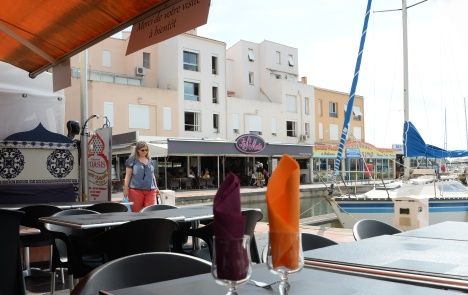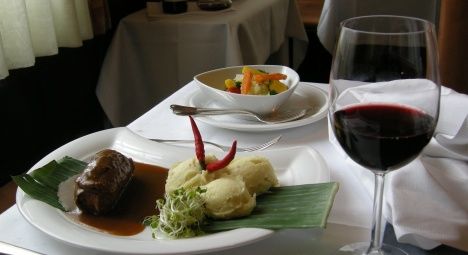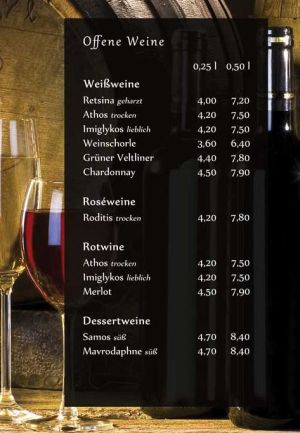There I was sitting in a small, well-kept restaurant in a tourist town in the wine region of southern France. I was alone and wanted to have a small snack at noon. The menu: varied, region-specific, attractive; the wine list limited to a few "open wines", house wines, so to speak. Just right for the small meal: "Un quart de rouge en pichet" (which means: a "Viertele", please). The "Viertele" was served, but the wine was almost undrinkable. Not only was it a meaningless, cheap, mass-produced wine, it was also served far too cold (obviously straight from the fridge), and was already oxidised. This is supposed to be a "house wine"? Normally, a dispute with the landlady or landlord follows. This time, however, I was deep in thought, annoyed, depressed, without any understanding, because the same thing has happened to me many times, even in places where wine is part of the central gastronomic culture.
 |
| In a small restaurant in the middle of the southern French wine region (Photo: P. Züllig) |
Gastro wines, what do we mean by that? What should they be like? Not a new topic, but a delicate one. Every wine drinker - but also every innkeeper - has stories to tell. Instead of drinking (and eating), I jotted down a few thoughts and forgot to reject the wine. It would probably have been replaced - with the same incredibly banal wine, but this time not ice cold and not oxidised, simply from another, a new bottle. But that doesn't make things any better. "Open wines" - wine lovers, used to the name and label, turn up their noses - are not as bad as their reputation. "Open wines" can be a proposition for those who don't do a dance around wine, but simply like to drink wine with their meal. House wine is not a bad term for open wines, as it means: "It belongs to the house, corresponds to the house culture, the house stands by this wine", even if the menu says "open wines" and not "house wines". Linguistically, "wine for serving" is much more non-committal.
 |
| Does a bottle of wine always go with a good meal? Can't it also be a "house wine" once in a while? (Photo: P. Züllig) |
I'm talking about the simple, good restaurants where you go for a meal in everyday life (especially at lunchtime) when you're not at home, or where you treat yourself to a nightcap in the evening and order a glass of wine instead of the obligatory beer. What is served as wine in many cases, in my experience in the majority, would not be accepted as food on the plate. As wine, however - whether white, rosé or red - there are apparently hardly any complaints, so few that the wine continues to be served, often for months and years. Wine lovers stick to bottled wines - they are increasingly also offered by the glass - and everyone else - the wine philistines, many a landlord probably thinks - is usually content with what is on offer. "Open wines" have to be affordable and - excluding demands - drinkable, hardly anyone talks about enjoyment. What goes beyond that is too much to ask: "Just think of the costs: service, glasses, bar, storage, etc.". That's where the margin gets small!"
 |
| A not entirely untypical wine list (Photo: P. Züllig) |
How often have I heard this, in every possible variation. But is it true? No, decidedly not! There are small, good, "open" wines, also from many producers with names and good reputations. Their "simplest" wines, the so-called basic wines, often "litre wines", they are what is called a good "gastro wine", an alternative to the mass wines, industrially produced somewhere in the world. What is often offered in restaurants under the name "gastro wine" is anything but gastro-friendly, just "cheap", in other words: cheap. It's just so convenient to have the beverage dealer, who brings all the different waters and usually also the beer to the house, also deliver the "open wine". "We have another offer, popular, drinkable and also cheap. You'll pay three times as much for this wine in a bottle," the supplier argues. Often this is true, the wine can be quite drinkable, decent, maybe even good, but it is usually "faceless". Whether it suits the restaurant, the food, the culture of the house is irrelevant. The main thing is that it is profitable.
 |
| The wine list is the business card of the house (Photo: P. Züllig) |
Far be it from me to start bashing the landlords here. But as a wine drinker, on the road a lot for many years, this has shaped my experience with open wines and clouded the picture.
I still sit in front of my almost undrinkable wine, with my meal that has become cold in the meantime, poking at the soup and seasoning the couscous, listlessly, without joy. All the petty, meaningless, stale, oxidised open wines I've encountered over the years reappear. The good ones - they really do exist - are not remembered, they have disappeared into everyday life, have joined the ranks of the good bottled wines that I have also drunk in restaurants. But the lousy wines, they stuck. They are calling cards that one keeps in one's memory, calling cards of unculture or lack of culture. I put down the money for the consumption, leave the restaurant - without a greeting - and will certainly never go there again, even though it is on the way and I often pass by there.
But the problem with "open wines" is not only with the buyer, who often invests too little time, interest and care, it is all too often also with the staff. The wines are served too cold, too warm, in impossible containers; they are often kept too long and in the wrong places, left open or even poured together. For many, wine culture only begins where the cork pops, where first - the left hand behind the back - a small sip is poured for tasting, where the glasses are exchanged (depending on the price of the bottle) and where the closure can only be a cork (which then lies neatly next to the bottle).
Good gastronomic wines do not need this ritual. They can also be "open" in everyday life, where only a "Viertele" or a "quart de rouge en pichet" is ordered. Namely, when they are not only drinkable, but also have a face, a character, a personality. The wine culture of a house can be better measured by the "open" wine than by a large wine list; namely when the small, the cultivated house wine is also at home there.
Sincerely
Yours sincerely